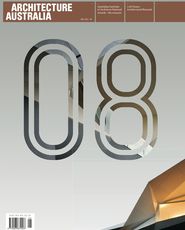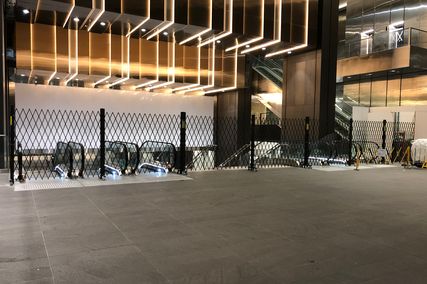VALE RAIA
I looked up from my board and suddenly we are the AIA … that is, the Australian Institute of Architects, not to be confused with the real AIA. I can recall an emailed survey, stating that this wasn’t a survey, some eighteen months ago and I have been reading between lines from the CEO for some time … but how did this happen?
Now, this is not your dyed-in-the-wool “monarchist” here, but a member who feels that the process the Institute has followed has been perfunctory, to say the least. I don’t recall a survey (referendum?) seeking the approval of the majority of members for a fundamental change to the constitution. Or did it fly by my virtual space?
Bruce Baldey F[R]AIA
legal loophole
I was shocked and angry at the underhand way that the members of the RAIA National Council have exploited a legal loophole to downgrade the Royal Australian Institute of Architects and have changed its name to suit their own personal political agenda. So too I am sure are a very great number of other Institute members.
Only a very few years ago a vote of members was taken and those proponents of the scheme to drop the prefix “Royal” did not get the numbers required to legally change the name. The result was legally and morally binding even though it was not what the National Council and Executive wanted.
That and the defeat of the Republic Referendum should have been the end of the matter. But no! The National Council and Executive have acted to circumvent this vote and to exploit a legal loophole as a fait accompli in defiance of those members who voted against it.
The prefix Royal is an indication to the public that the work of members of the Institute will be of the highest order and that they will display integrity and trust without any political bias. Without it the Institute becomes a trade association with no particular standards expected of it.
I wrote to the Executive along the lines given above to complain about the actions of the National Council and Executive. The reply was predictable. It talked about having done surveys, canvassing, etc., of focus groups, some Institute members, stakeholders and the general public to support their actions. What they failed to understand was that these surveys and canvassing were irrelevant for two reasons.
Firstly, the surveys, canvassing, etc., should not have been done. The issue was voted on by the full membership of the RAIA and the proponents for change did not get the numbers to legally effect a change of name. The result was legally and morally binding and had to be respected and accepted by the National Council and Executive.
Secondly, as everyone knows who has watched the TV programs Yes Minister and Yes Prime Minister, the results of surveys, canvassing and consultations are meaningless. They produce whatever result is wanted depending on what questions are asked, how the questions are phrased and of whom the questions are asked. The only clear indication was the vote which was taken previously and that should have been respected.
If the situation is looked at objectively, having “The Royal Australian Institute of Architects” trading as “The Australian Institute of Architects” makes the Institute look ridiculous and the National Council and Executive look ridiculous and seemingly behaving like spoilt children determined to get their own way. The exploitation of a legal loophole to achieve a particular and controversial outcome lowers the public standing of the Institute.
I suggest that all those members who object to the de facto fait accompli name change and the way it was carried out write in to the National Executive and register their objections and ask for the idea to be scrapped as not being in accord with the ideals of the Institute and the vote previously taken.
Frederic C. Warren APTC (Arch), FRAIA, RIBA
new graphics
I sent the following comments to the membership division upon viewing the new Institute member’s badge graphics. I am so appalled at its design that I feel compelled to circulate my opinions further in protest.
“Have just downloaded the member’s badge and unfortunately, I cannot let its design go without comment. In nearly forty years of learning and practising architecture there has not been much that has stirred a response like this in me. For a badge that is supposed to represent the pinnacle of the design profession, i.e. Architecture being the Mother of Arts, the current design has to be the most woeful design that could be imagined. MEMBER?? It should be dis-membered! It looks like something a first-year secretary of the AWU would have done as a cut-and-paste job to fill in time – grab the old logo, print out something on the office label maker, oops, sorry, don’t have different font sizes so this one will do and then stick it over the “Royal” – mmmm, looks a bit too big but since the label maker won’t change its font size, let’s shrink everything else down on the photocopier so we can keep it square, yes, that’s it!
Whoever designed it should go back to design classes at university and whoever approved it in the Institute organization should join them or be sacked – and I don’t particularly care how esteemed amongst the profession they may be, they got it wrong! The previous RAIA badge, without the word “member”, was something that one could feel proud of and want to display – and not because it had “Royal” in it or because it omitted the word “member”. It was simple but balanced and it communicated professionalism. The current badge focus is on “Member!” and it should be on “Australian Institute of Architects” or its emblem. It is after all a badge to identify members, not a members’ badge to identify the Institute. The second example, i.e. the one that has the emblem faded, is even worse – it looks like the plastic clip-on name tags that one gets handed at conferences, except that all one will read from a distance is Member. While I lay no claim to be a legendary designer, I graduated from high school with first-level art and I have survived in the industry for a long time and I am sure my design and art tutors at university all those years ago (Lloyd Rees, Guy Warren, Glen Murcutt, Richard Leplastrier and others) would have failed me for such an effort, had it been mine.”
Steve Gleeson
David Parken, CEO of the Australian Institute of Architects, responds.
In response to comments from Mr Baldey, Mr Warren and Mr Gleeson, whose feedback we appreciate, I confirm that the decision to review the brand of the Institute and subsequent decision to launch with a new trading name, updated livery and public advocacy campaign were made unanimously by the National Council and followed a significant process of market research.
It should be noted that the legal entity of the Institute will remain as The Royal Australian Institute of Architects and any change to the legal name will require the approval of 75 percent of members at a general meeting in accordance with our articles. As of 1 July 2008, a new trading name – the Australian Institute of Architects – came into effect. This initiative has been adopted by many organizations around Australia. While the trading name has changed, RAIA post-nominals remain in place, reflecting the legal entity and heritage of the Institute’s name.
The extensive research that led to this decision was, and remains, statistically robust and was one of many factors including an action from a national strategic planning session some three years ago that involved the National Council and all senior staff.
The member badge has been designed to draw in elements of the new branding, but appears distinctly different for obvious reasons relating to each of their applications.
National Council accepts that not every member may be entirely happy with the outcomes of this rebranding process. However, as CEO, I feel sure that the new branding and public promotion campaign reflect what the majority of members have called for and will be effective in making the Institute of Architects accessible and relevant to the public, government and industry.
David Parken LFRAIA, Chief Executive Officer, Australian Institute of Architects
Conference polemic
The cost of attending twenty-first-century Institute national conferences, rotating exclusively between two provinces, probably limits ease of participation by Institute rank and file. I was therefore grateful for Architecture Australia’s coverage and the effort that Dr Naomi Stead, Elizabeth Watson-Brown and Ben Hewett put into communicating the event in the last issue (Architecture Australia July/August 2008, vol 97 n0 4). In the absence of podcasts or downloads, their descriptions and critical comment, though mediated, gave me an insight into the forum.
The review by Carey Lyon and Neil Appleton didn’t offer the same generosity to absent members. I probably want to understand their position on corporate architecture as much as anyone and am even mildly open to their sceptical tone on environmental Wesleyanism. However, making the review a détournement to present their company manifesto struck me as opportunistic.
If the next conference were accessible, Lyon and Appleton would be speakers I’d pay a modest amount to hear more from directly. I’m curious to see their sketch points on sustainable building expanded, to learn what lies behind the urgent demand to build rather than talk or draw, and to know more of what troubles them when students get in line to buy eco morphology stuff. Speaking might be a better medium for them than maladroit prose.
Top of the table for me would be to see them return to their Queenscliff Centre as reviewed by Leon van Schaik of RMIT and published in this journal Jan/Feb 2005. I thought an argument was initiated that pitched it against the example of Council House 2. Van Schaik voiced Lyons’ conviction that sustainable building was an ordinary problem, unlike the big-shift CH2 idea. He noted that Lyons declared a 10 percent or less impost on construction costs compared to the 20 to 50 percent range quoted for CH2, and that there had been no specialist environmental consultant as for CH2, and claimed an identical outcome – the six-star GBCA (world leader) rating for both. The can-do tone of that position was there again in the ballad of Lyon and Appleton’s conference report. Confidence like that strikes me as uncommon.
CH2 has six-star GBCA certification as a fact. Quite an achievement. The same GBCA list of Green-Star-certified projects does not include the Queenscliff Centre. It was either not submitted or withdrawn before any rating result was obtained. Subsequently its alleged six-star status has been propagated in other journals. I’ve looked for errata in this publication since then that corrects the record.
I’d welcome comment by Mr van Schaik to clarify the claims of his review and his research methodology.
Michael Markham















